This article was published in Scientific American’s former blog network and reflects the views of the author, not necessarily those of Scientific American
In the interests of recycling old Tet Zoo material from the archives, here are some musings on giraffe deaths.
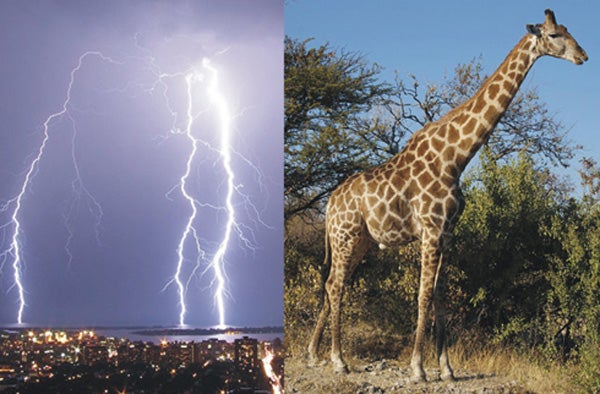
Lightning image by John R. Southern, CC BY-SA 2.0. Angolan giraffe Giraffa camelopardalis angolensis (c) Hans Hillewaert, CC BY-SA 4.0.
Lightning strikes may be a significant danger to giraffes in environments that have few tall trees and are topographically or geologically predisposed to attract lightning. One eyewitness report suggests that, during lightning storms, giraffes lower their heads and may even compete with one another to become lower in height (J. Schamotta, pers. comm.), though whether this is accurate was doubted by giraffe specialist Anne Dagg. Between 1996 and 1999, the Rhino and Lion Reserve near Krugersdorp, South Africa, had two of its three giraffes killed by lightning – the third animal (a juvenile) was also struck but survived. Betsy the giraffe was killed by lightning at Walt Disney World in Florida in 2003 (in front of lots of witnesses). A juvenile giraffe at Louisiana’s Global Wildlife Center, named Dusty, was killed after lightning struck a nearby tree.
On supporting science journalism
If you're enjoying this article, consider supporting our award-winning journalism by subscribing. By purchasing a subscription you are helping to ensure the future of impactful stories about the discoveries and ideas shaping our world today.
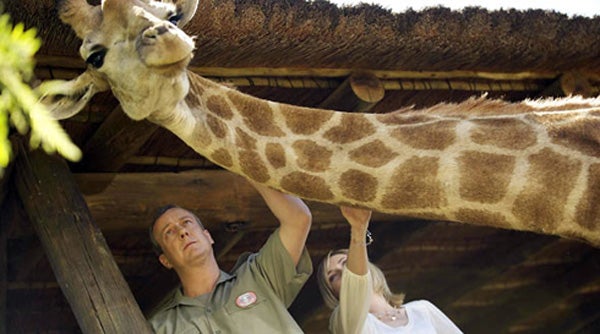
Hamley – a South African giraffe G. c. giraffa who lived on the Glen Afric reserve in South Africa – was (apparently) struck by lightning and killed in November 2010. Hamley [shown above] was a famous giraffe with a TV career; he starred in the ITV television series Wild At Heart and was much liked and admired by his human co-stars (Wild At Heart is a drama series about a British family who go to live in Africa).
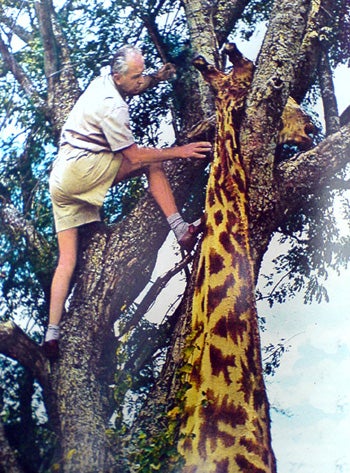
Bernard Grzimek (it's pronounced 'chee-mek', apparently) and unfortunate giraffe. As referenced in All Your Yesterdays.
While it should be noted that, in the Krugersdorp case, the giraffes had been experimentally introduced into an unsuitable habitat, giraffes, cows and other artiodactyls in natural conditions elsewhere are susceptible to death by lightning and entire herds can be killed by a single strike, typically while sheltering under a tree. Wild cattle, antelopes and other animals have also been reported killed in this way (e.g., Carnaby 2005).
Herbivores sometimes die after getting their necks caught in branches. This is a hazard for antlered deer but there are also cases where unantlered deer, horses and other animals have died this way too. And it’s happened, at least once, to a giraffe. In this case, the unfortunate animal slipped while feeding and got its neck caught in a forked branch. Its carcass then remained there, suspended, until people pulled it down. Some of you will recognise the gentleman in the photo as Bernhard Grzimek (1909-1987); I think the giraffe is a Masai giraffe Giraffa tippelskirchi. The photo you see here was featured in Animals magazine (the ancestor to BBC Wildlife) during the 1960s.
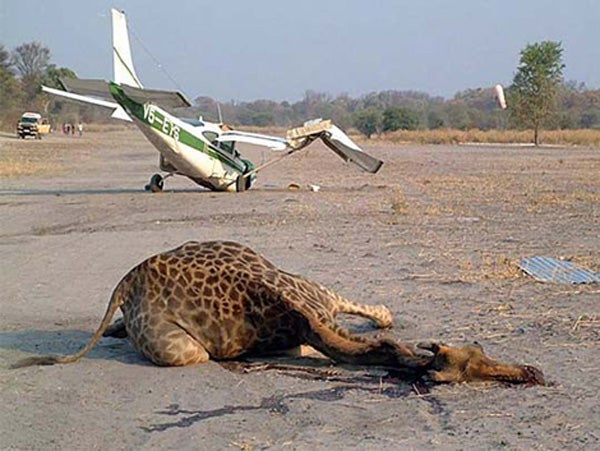
The plane belonged to a wildlife charity studying hunting dogs; I regret that I haven't been able to trace the name of the photographer.
Here’s an infamous photo, taken at Santawani airstrip in Bostwana in 2000. It pretty much speaks for itself. The plane – a Cessna 172 (or 182?) – was taking off when the giraffe ran across the runway. The pilot survived. Whenever this photo appears online, people descend to say how terrible and/or inept the pilot must have been to collide with a giraffe. What they fail to appreciate is that there are certain moments within both takeoff and landing where pilots and their vehicles have an incredibly limited number of options and simply cannot take alternative action.
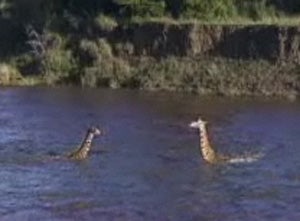
Giraffes in deep water. They try to cross a river but change their minds and turn back. Screengrab from the BBC series Big Cat Diary.
Finally... do giraffes ever drown? Long-time readers will be familiar with the previous Tet Zoo coverage of this issue. However, that pertained to the wading, swimming and floating abilities of giraffes (Henderson & Naish 2010, Naish 2010). There are a few cases where giraffes have slipped up in shallow water and either drowned, or nearly drowned. It might seem surprising and dumb that animals might die this way, but... accidents happen to the best of us.
For previous Tet Zoo articles on giraffes (or relevant to giraffes), see...
Inside Nature’s Giants part IV: the incredible anatomy of the giraffe
Testing the flotation dynamics and swimming abilities of giraffes by way of computational analysis
Refs - -
Carnaby, T. 2005. Beat about the Bush: Mammals. Jacana Publishers, Johannesburg.
Henderson, D. M. & Naish, D. 2010. Predicting the buoyancy, equilibrium and potential swimming ability of giraffes by computational analysis. Journal of Theoretical Biology 265, 151-159.
Naish, D. 2010. Will it float? Scientific American 304 (1), 22.